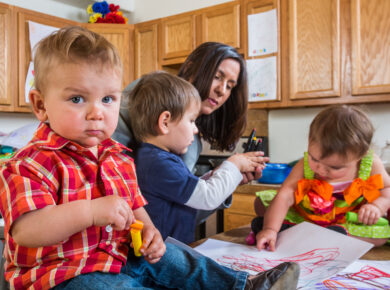How Many Hours Should Homeschooling Take?

Introduction
If you are new to homeschooling, congratulations on taking the first steps on this enriching journey. You may at first feel overwhelmed—just know that this is completely normal! There are a lot of questions that come with homeschooling. One is the length of time it takes. You may be surprised to hear that your school day will be much shorter compared to public or private school. Let’s explore some reasons for this.
Why does it take so little time?
At a typical brick-and-mortar school, the school day is 8:00 to 3:30, with 30 minutes for lunch. That’s seven hours each day. While you may think all that time spent in learning, this would not be accurate. First, there is a settling-in period. This means children come in and take time to put away backpacks, sharpen pencils, make lunch choices, and find take-home communications, which the teacher must walk around and verify.
Then, there are school announcements and getting the children on task as they look for books, pass out papers, find the right page, and slip out of their seats to talk to a friend on the opposite side of the room.
During the lesson, numerous questions will be asked, many of which are not about the lesson itself; and classroom management and discipline will take a lot of time. The students are often distracted and unable to focus. Then, it’s time to put their books away and prepare for the computer lab. The teacher passes out log-in cards, and the students line up. The teacher must remind them to tie their shoes and be quiet in the hallways. This pattern keeps going for the rest of the day. One hour of traditional school roughly translates to about 20-30 minutes of a typical homeschooler’s day, which is why you can get all the work done in half the time they do in public school.
If you are following the CHC lesson plans and completing the work in 2 ½ to 3 hours, you are doing just the right amount of core academic work. As long as you follow the curriculum, your children will be on track. If you have a five-year-old who learns her lesson in an hour, why make her take two hours? If your five-year-old then wants to do more work, let her. There will be days when she wants to do the minimum, which is also okay. Homeschooling is about going at each child’s pace and ensuring he understands each lesson before moving on.
Estimating the time needed for homeschool
It can be confusing at first to homeschool parents when they experience their students finishing their studies in half the time that their public school counterparts do. Rather than compare your teaching to public or private school, compare your teaching in the homeschool to one-on-one tutoring. With private tutoring lessons, parents see their children make rapid progress. Why? Because 90 minutes of weekly tutoring over a six-week period is targeted and concentrated enough to bring real results! Homeschooling is like having a private tutor; children make rapid progress with one-on-one attention.
Elementary school
For an elementary-aged child, one and a half hours a day of homeschooling is sufficient for core subjects. Of course, first grade is different from fourth grade, so as they get older, this time may increase slightly with their workload—but not by much.
Spending the rest of the day playing and working on hobbies and chores ensures they continue learning. Remember, learning is not just books and lessons. Many activities, such as cooking, dominoes, computer games, and puzzles, will engage their brain and help them learn as well. Many of these activities involve math and reading skills, which will help your child in all walks of life.
Middle school
For middle school, the time increases to about 2 to 3 hours a day for the core subjects. What your child is working on that day will impact how long it will take him. If he’s focusing on a subject he is proficient in, it may only take 2 hours, but if he is on a subject he’s struggling with, it will naturally take a bit longer as he learns to grasp the concepts being taught.
Another thing that can affect the length of the school day is the type of hands-on projects the child chooses for literature, science, and history. (Hands-on projects are included in CHC’s literature, science, and history courses). If the child chooses projects that take more time, then of course the school day will take longer. But since these are hands-on projects instead of seatwork, and were chosen by the child, the extra time required to complete the projects is unlikely to be burdensome.
High school
High school should take around 4 hours each day for core subjects. It is not necessary to spend all day on high school subjects, as you do not want to push your student too far or too fast. Many homeschoolers find that even without pushing, their children are prepared academically for local college by age 16. Academic readiness is one thing, though, and personal maturity is another. There is no point in rushing through the academic side of education when your young adult is not yet ready to enter the next stage of life, whether it be college, a trade, or a vocation.
Final thoughts
With homeschooling, you take the waiting time out, and your children can focus on getting a well-rounded education through lessons and enrichment activities (both in and out of school time). This is why your children are able to get all of their school work done in about half the time.
About Sandra Garant
Sandra Garant is a veteran homeschooling mom, certified teacher, writer, attorney, and administrative law judge. She taught her three children at home until they were ready for college. She tutored students in writing for many years and is the author of Language of God, Level F and Language of God, Level G.
Related Blogs
If you enjoyed this article, you might be interested in the related articles below.
Favorites
Explore CHC’s top favorites! From art to literature, science to hands-on religion, CHC has materials to enrich every Catholic homeschool.


















